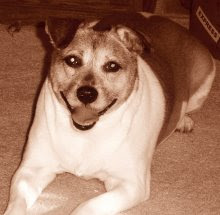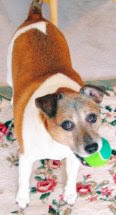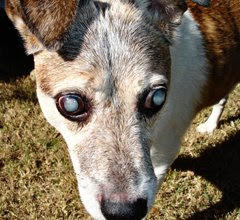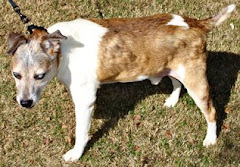If it wasn’t our drive to get Hunter well, I’m not sure I would have been able to give the shots and draw the blood. I’m a squeamish kind of person, especially about shots and veins. I’m getting warm just typing this…no kidding.
Hopefully, if you’re reading this and your pet has been diagnosed with diabetes, you’ll have an easier time in getting a blood sample. Hunter is a fighter, although when he was at his sickest, he didn’t fight that much. He’s feeling and acting more like normal, so he’s back to being a fighter. We have to use a muzzle on him. We lay him on his side, one person holds his front legs and another straddles him. I’m the one who straddles him to get the sample. We have everything set-up and ready; the meter with the strip, lancet, and cotton ball with alcohol.
Perhaps sticking his ear would get a better sample, but after viewing videos online, there’s no way I could do that. Unfortunately, I usually have to stick him a few times to get a good sample. It’s rare to get a good sample on one try.
This was his first glucose curve since he was on the Lysodren and here are the numbers. He get’s his first shot within five minutes of him finishing his breakfast, which is around 8:45. You take the first sample two hours after shot #1 and every two hours until 10:45 pm.
Time Number
10:45 am - 170
12:45 pm - 170
2:45 - 111
4:45 - 114
6:45 - 97
8:45 - 130
10:45 pm - 205
We were a bit concerned about the last number being at 205. So, yesterday, we took a sample at 10:45 am and it was 209 and again at 2:45 pm and it was at 184.
The doctor called me back yesterday afternoon and he was very pleased with his numbers! I was so surprised since to me it looked like he was all over the place. I was busy reading on the internet before he called for a “safe” range. It seems they vary; however, the doctor recommends anywhere between 60 and 180. He wasn’t too concerned that Hunter’s numbers did reach up in the 200’s, as long as they come down.
The time to be concerned is when he starts to drink more water and needs to urinate more. I’ve decided to keep the gallon jug, which I have marked off, to track his water usage. After seeing Hunter drink so much water these past few months, it’s hard to remember what was “normal” for him. I have the jug marked off to around 5 cups. The recipe is supposed to be 1 ounce of water for every pound. Hunter has gained back some weight, in the past 2 ½ weeks and I estimate him to be around 32-34 lbs. I also started to cut back on the food a little bit, to around 1 ¼ cups of food for each feeding. I’m still adding a little less than ¼ cup of scrambled eggs to his food, or he wouldn’t eat. We’ve basically stopped all treats, except for some doggie cookies I found online for diabetic dogs.
In about three weeks, I’ll make an appointment for another ACTH test. We were hoping that we would be able to cut back on his amount of insulin, but that’s not going to happen. When I was looking for the “safe range” for glucose numbers, I did read that dogs that have Cushing’s and diabetes, usually have to take more insulin. That seems to be holding true.



